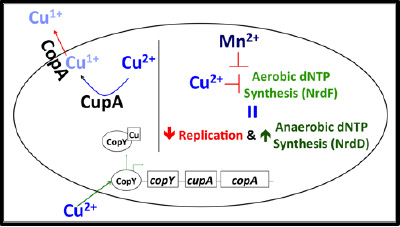Metals play a role as cofactors or structural components of roughly 40% of all proteins. Specifically, my laboratory will focus on copper, which is universally toxic to bacteria, a fact that is exploited by the host immune system and can be further exploited to develop new treatments for multiple bacterial infections. Many aspects of the bacterial copper export operon (cop operon) are conserved such as the repressor (CopY), the copper chaperone (CupA), and the copper exporter (CopA). However, there are vast differences in how each system responds to copper stress, with each difference having implications in developing new therapeutics. Additionally, across many of these bacterial landscapes, the results of copper intoxication and mechanisms of copper toxicity remain unknown.
 My previous research has shown that streptococcal species Streptococcus pneumoniae and Streptococcus pyogenes need a functional CopA for and found that a novel S. pneumoniae mechanism of copper toxicity is mismetallating a ribonucleotide reductase (NrdF), by displacing manganese, thus inhibiting nucleotide synthesis. In addition to offering a better understanding of how bacteria interact with copper, these studies provide new and druggable targets that are essential to bacterial survival in the host and thus, valuably contribute to the fight against antibiotic resistant microbes. To expand on these findings and further explore bacterial copper homeostasis, my laboratory will use a multipronged experimental approach (biochemical and biophysical assays, genomics, and animal models), and S. pneumoniae as a model organism (with S. pyogenes as a subsequent target pathogen) to ask five pressing questions addressing both health-related and basic science issues in the metallobiology field:
My previous research has shown that streptococcal species Streptococcus pneumoniae and Streptococcus pyogenes need a functional CopA for and found that a novel S. pneumoniae mechanism of copper toxicity is mismetallating a ribonucleotide reductase (NrdF), by displacing manganese, thus inhibiting nucleotide synthesis. In addition to offering a better understanding of how bacteria interact with copper, these studies provide new and druggable targets that are essential to bacterial survival in the host and thus, valuably contribute to the fight against antibiotic resistant microbes. To expand on these findings and further explore bacterial copper homeostasis, my laboratory will use a multipronged experimental approach (biochemical and biophysical assays, genomics, and animal models), and S. pneumoniae as a model organism (with S. pyogenes as a subsequent target pathogen) to ask five pressing questions addressing both health-related and basic science issues in the metallobiology field:
- How do bacteria process copper (examining operon regulation and testing additional metal involvement)?
- What are alternative features used by bacteria to limit copper toxicity (investigating how bacteria defuse potential byproducts and/or limit copper uptake)?
- What are other mechanisms of copper toxicity (copper toxicity mechanisms vary from bacterium to bacterium and due to mismetallation, it is likely that multiple methods per organism exists that overlap with other bacteria)?
- Are pathways affected by copper toxicity relevant enough to be targets for small molecule therapeutics (my previous data already suggests that CopA is a viable target to explore in a screen based format)?
- Can bacteria use internal/external metal sensing as a means to understand its location to promote survival i.e. elucidating the orchestrated bacterial response to copper stress (which tools are employed by the bacterium under host metal conditions versus growth in nutrient rich conditions)?


